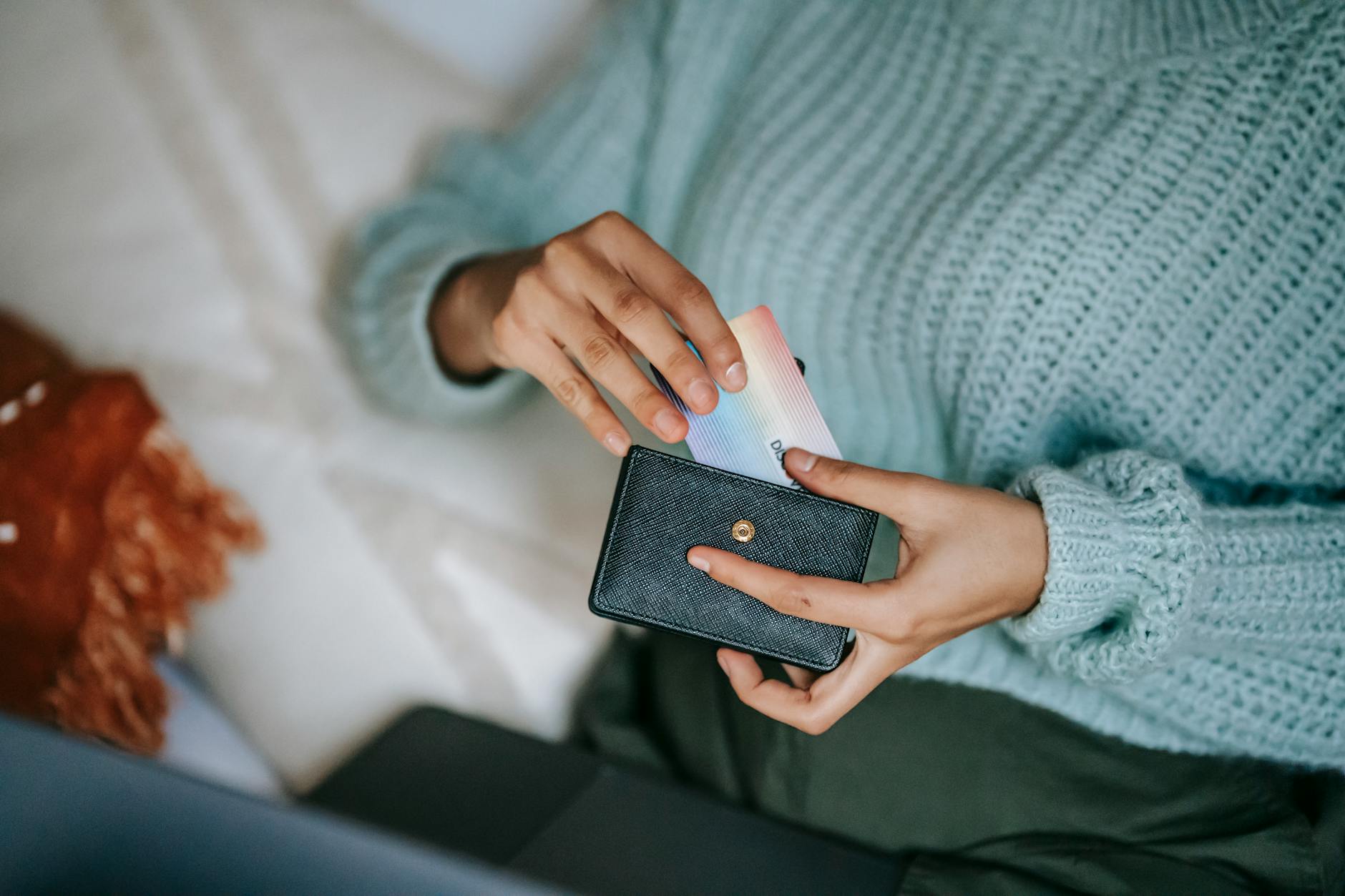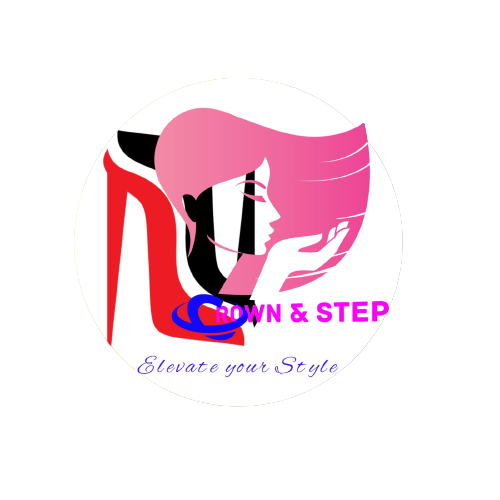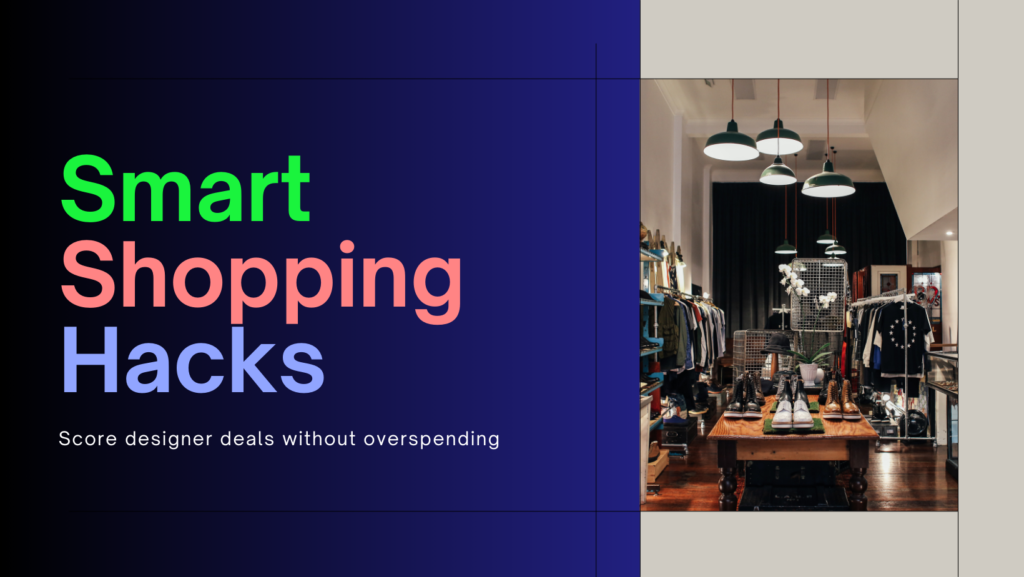Designer clothes have a special allure—they elevate your look, boost your confidence, and embody luxury. But let’s face it: the price tags can be intimidating. The good news? You don’t need a bank-breaking budget to own stylish, high-end pieces. This post will walk you through simple, actionable tips to score designer finds without overspending. Whether it’s uncovering secret sales, using tech tools, or shopping smarter, you’ll learn how to make luxury fashion work for your wallet.
The Value of Designer Clothes
Designer clothes go beyond their hefty price tags. For many, they offer unparalleled craftsmanship, timeless appeal, and a true sense of value that mass-produced garments often can’t replicate. Understanding why designer pieces stand out will help you see them as more than just luxury—they’re smart investments for your closet. Here’s why.
Quality and Craftsmanship

Photo by Ron Lach
One of the hallmarks of designer clothing is quality. It starts with the materials—think soft Italian cashmere, buttery lambskin leather, or meticulously woven silk. Designer brands often source the finest fabrics that not only feel luxurious but also stand the test of time.
The craftsmanship is another factor that sets these garments apart. Designer items aren’t just “put together;” they’re crafted. Skilled artisans focus on every tiny detail, from perfectly aligned seams to hand-sewn embellishments. Small touches like double stitching or reinforced hems may seem invisible at first, but they make a huge difference in how well a piece holds up after years of use.
Unlike fast fashion, where mass production sacrifices precision, designer garments are built for durability and elegance. Ever notice how a designer jacket fits almost like it was tailored for you? That’s no coincidence—attention to shaping and structure is part of their design DNA.
Long-term Investment
When you buy a designer piece, you’re not just spending money—you’re saving it in the long run. How? Because quality never goes out of style. Items like a Burberry trench coat or a Chanel Little Black Dress can last decades if cared for properly. And thanks to their timeless designs, they remain wearable year after year, avoiding the “fad shelf life” found in fast fashion.
Some designer items even appreciate in value. For instance, a Hermès Birkin bag isn’t just an accessory—it’s a cultural icon that has consistently increased in price over time. Similarly, brands like Gucci, Dior, and Louis Vuitton have core pieces that retain high resale value if kept in good condition.
Think of it as cost-per-wear. A well-made designer blazer may cost significantly more upfront than ten fast-fashion blazers combined, but it could last a decade or more—making it a better financial choice over time.
Designer clothing also plays into sustainability. By investing in fewer, better-quality pieces, you reduce waste and support craftsmanship over mass manufacturing. Plus, storing or reselling items keeps them out of landfills longer, making them a more eco-conscious choice. With every investment, you’re contributing to a wardrobe that lasts—for you and for the planet.
Shopping Secondhand: Hidden Gems at Discounted Prices
If you’re on the hunt for designer clothes without the designer price tags, secondhand shopping is your best-kept secret. From curated online platforms to local consignment shops, there’s no shortage of options to snag luxury fashion at a fraction of its original cost. With sustainability as an added bonus, shopping pre-owned is a win-win.
Exploring Resale Platforms

Photo by Anastasiya Badun
Online resale platforms have completely transformed the way we shop for pre-owned designer items. Whether you’re after a vintage Gucci bag or gently-used Jimmy Choo heels, these websites make it simple, safe, and stylish.
- The RealReal: Known for its expert authentication process, this platform specializes in high-end luxury items. With categories spanning from handbags to jewelry, you can shop with confidence knowing you’re getting the real deal.
- Poshmark: Perfect for both buying and selling, Poshmark caters to a wide range of budgets and offers everything from contemporary brands to luxury pieces. The built-in messaging system also lets you connect with sellers to negotiate prices.
- Vestiaire Collective: This global platform is all about sustainable luxury. Items go through a quality control team before reaching buyers, ensuring authenticity and condition standards are met.
These platforms also offer features such as saved searches and notifications, making it easier to find the exact designer piece you’re eyeing. Don’t forget to check for seasonal sales or discounts often rolled out on these sites!
Consignment Stores
Looking for deals while supporting local businesses? Consignment shops are mini treasure troves for designer gems. Unlike thrift stores, consignment shops often carry higher-end items that are vetted for quality.
- Local Boutiques: Many small consignment boutiques specialize in curated pieces, from last season’s designer collections to rare vintage finds. These stores are ideal for scoring unique items while contributing to the local economy.
- Nationwide Options: Chains like Plato’s Closet and Buffalo Exchange also cater to thrift-friendly shoppers who want quality in every rack. While they may not always feature high-end designer labels, you can still find prestige items from brands like Coach or Ray-Ban.
Shopping in-person at consignment stores means you can examine the quality up close. Look for tags, stitching, and hardware to ensure the item is in great condition. Plus, many stores operate on a seasonal basis, so you’re bound to find a fresh selection every few months.
Shopping secondhand isn’t just about saving money; it’s about finding standout pieces that tell a story. Whether you’re browsing online or exploring local shops, the thrill of hunting for hidden gems makes every find feel special.
Maximizing Sample Sales and Outlet Shopping
Shopping for designer clothes at a discount takes strategy, patience, and a little bit of inside knowledge. If you’re willing to spend some time planning, sample sales and outlet stores can become your go-to for snagging luxury items at a fraction of the cost. Below, we’ll guide you through how to make the most out of these opportunities.
Navigating Sample Sales
Sample sales are treasure troves for fashion lovers, offering steep discounts on designer collections. These sales often feature pieces used for runway shows, photoshoots, or prototypes that never went into full production. Ready to dive in? Here are practical tips for both in-person and online sample shopping:
- Plan Ahead
Many sample sales are announced last minute, so follow brands on social media or subscribe to their newsletters. Websites like 260 Sample Sale and Chicmi often list upcoming sales, particularly in major cities like New York and Los Angeles. - Arrive Early (or Go Late)
For in-person sales, early shoppers usually get the first pick—especially when sizes are limited. However, some sample sales slash prices further toward the end, so it could pay off to be one of the last people in the door. - Know Your Measurements
Sample items often don’t follow standard sizing. Bring a measuring tape or know your measurements by heart to save time in the fitting process—especially when online sales don’t allow returns. - Dress Comfortably
Think slip-on shoes and fitted clothing you can layer over or under. Some sample sales don’t provide fitting rooms, so being prepared will help you shop faster. - Set a Budget
Prices can tempt even the most careful shoppers. Decide on a budget beforehand, or use cash to limit overspending. - Check Quality
Pieces at sample sales may have slight imperfections, but knowing how to spot minor issues versus unfixable flaws is key. Stains, loose stitching, or missing buttons are one thing—tears or structural damage are another.
Online sample sales are growing in popularity, too. Platforms like The Outnet, Rue La La, and 260 Sample Sale have streamlined the virtual experience, offering perks like sorting by size and setting search alerts for your favorite brands.
Outlet Stores & Discount Retailers
Outlet stores are a step above traditional retailers when it comes to consistent year-round deals on designer items. Unlike sample sales, outlets often carry more inventory and broader size ranges, making them ideal for “planned splurges.”
Here are some of the most reliable outlets and retailers for snagging designer finds:
- Nordstrom Rack
Known for major markdowns on luxury labels, Nordstrom Rack’s selection includes everything from clothing to shoes and accessories. Don’t miss their “Clear the Rack” events, where discounts can go up an extra 25%. - Saks Off 5th
This outlet is perfect for finding deals on high-end brands like Diane von Furstenberg or Alexander McQueen. It’s also worth checking for their online sales, which often carry exclusive discounts. - Neiman Marcus Last Call
Neiman Marcus’s outlet features luxury essentials, particularly high-quality leather goods and outerwear. End-of-season sales can drive prices down even further—up to 75% off in some cases!
Other trusted outlets include The Outnet (by Net-a-Porter), Bloomingdale’s The Outlet, and Century 21, each offering incredible savings on past-season stock. Shopping at outlets isn’t without its challenges, though, so here are some tips to navigate them more effectively:
- Compare “Made for Outlet” vs. Genuine Inventory
Some outlet items are specifically produced for outlets, often at a lower quality. Look for tags that indicate past-season collections or brands with regular inventory from main designer lines. - Shop Off-Season
For the best deals, aim to shop in January or July during end-of-season clearance events. - Check Loyalty Programs
Many outlet brands offer rewards or exclusive deals for loyal shoppers. Sign up for newsletters to keep up with special events and discounts. - Explore Premium Outlet Malls
Locations like Woodbury Common Premium Outlets (NY) or Sawgrass Mills (FL) are known for extensive luxury options, from Gucci to Saint Laurent, often at 30-70% off.
By combining sample sales with outlet shopping, you create a formula for owning stunning designer pieces without the hefty price tag. Remember, patience pays off when it comes to scoring hidden gems.
Leveraging Online Tools and Technology
Finding designer clothes at a discount doesn’t have to require hours of scouring the internet anymore. With the rise of cash-back platforms, coupon extensions, and sales alert tools, you can now identify deals while sipping your morning coffee. These tools are not only convenient but can also save you significant cash.
Using Cash-Back and Coupon Platforms

Photo by Kaboompics.com
If you’re not leveraging cash-back services or automated coupon tools, you’re leaving money on the table. They’re like digital assistants that quietly work behind the scenes to save you cash.
Some standout options include:
- Rakuten: This platform gives users cash back when shopping from partnered retailers. Simply shop through their site or app, and you can earn a percentage of your purchase refunded directly to PayPal or via check every quarter. It’s perfect for big purchases or regular online shopping.
- Honey: A robust browser extension that automatically scans for coupon codes at checkout. But Honey also has a feature called “Droplist,” which keeps track of items you’re eyeing and alerts you when prices drop.
- RetailMeNot: This service is great for both in-store and online purchases. It’s a treasure trove for coupons, sales, and even cash-back opportunities. Simultaneously use it with other tools like Rakuten to maximize savings.
- Ibotta: Though more focused on groceries, Ibotta has expanded to online shopping. Once you find an offer, you just upload a receipt or make purchases through linked retailers to redeem cash rewards.
- Fetch Rewards: Unlike other platforms, all you need to do is scan your receipt. Points can be exchanged for gift cards or added discounts.
Consider stacking savings. For instance, shop through Rakuten, apply Honey coupon codes, and pay with a rewards credit card for triple the benefits. Think of it as layering up for the winter—each layer adds a bit more warmth (or in this case, savings).
Tracking Sales with Websites and Alerts
When trying to nab that perfect designer piece, timing is everything. Instead of obsessively refreshing product pages, let specialized tools do the heavy lifting.
- Lyst.com: Known as a fashion search engine, Lyst aggregates items from thousands of designer stores in one place. You can either search directly for specific brands or set alerts on products. If the price drops or a sale goes live, Lyst sends you an email notification. It’s like having a personal shopper for discounts.
- Shoptagr (now Karma): This browser extension allows you to save products across multiple stores and notifies you when there’s a price drop, low inventory, or restock.
- Google Shopping Alerts: Use Google’s Shopping tab to search for designer items and compare prices. Set up alerts for when discounts become available. This tool works well for tracking big-ticket designer items.
- The Outnet’s Alerts: The sister company to Net-a-Porter, The Outnet specializes in discounted past-season designer items. Sign up for their email updates to receive details on flash sales or exclusive deals.
- Email Subscriptions and Store Apps: Many retailers and brands announce sales exclusively through their email newsletters or apps. If you have a favorite designer, download their app or subscribe for alerts to stay updated on private sales or special discounts.
Use these tools wisely and you’ll never miss out on a good deal. For example, while Lyst is perfect for browsing globally, Google Shopping keeps things localized. Pairing these two tools provides a wider safety net to catch sales you’d otherwise miss.
Between cash-back platforms and sales alerts, technology has essentially made saving money a no-brainer. By combining a couple of these tools, you’ll be well-equipped to snag designer clothes at unbeatable prices.
Timing Your Purchases and Prioritizing Essentials
Smart shopping isn’t just about finding the best deals—it’s about knowing when to buy and making thoughtful choices that last. Timing plays a significant role in snagging designer pieces for less, while focusing on essentials ensures that your wardrobe remains versatile and timeless.
Seasonal Sales and Flash Deals

Photo by Liza Summer
If you’re hunting for high-end clothing at a fraction of the price, your biggest ally is timing. Retailers follow predictable patterns when it comes to sales, so planning around these can lead to major savings.
- End-of-Season Sales: The fashion industry operates on seasonal cycles—spring, summer, fall, and winter. Toward the end of each season (typically January for winter and late July-August for summer), stores clear out old inventory to make way for next season’s styles. This is your opportunity to grab designer items at up to 60%-80% off. Think of it as scoring winter coats summer-style—hot deal, cold weather essential.
- Black Friday and Cyber Monday: These heavy discount days in late November are goldmines for snagging designer pieces. Pair your tech-savvy tools like browser extensions for price tracking with these sales for double the advantage.
- Holiday and Post-Holiday Clearances: Items leftover after Christmas often see price cuts in January, while July is prime time for discounts on summer apparel. Monitor your favorite luxury retailers for markdowns on items they didn’t move during peak seasons.
Lastly, stay ready for flash sales. These quick, limited-time discounts require you to act fast! Bookmark platforms like The Outnet, Gilt, or Yoox, which specialize in discounted designer goods. Additionally, sign up for email notifications or app alerts to shop as soon as deals drop.
Focus on Timeless Pieces
In the pursuit of designer bargains, don’t just chase trends—focus on building a wardrobe that stands the test of time. Timeless pieces keep you looking polished year after year while minimizing the need to replace items constantly.
Some investment-worthy staples include:
- A Classic Trench Coat: Immortalized by brands like Burberry, the trench coat is a versatile layer that works for nearly every season. Whether over a suit, dress, or casual jeans, it elevates any look.
- The Little Black Dress (LBD): Nothing speaks longevity in fashion like an impeccably tailored LBD. Choose a simple, elegant cut, and you’ll have a go-to outfit for countless occasions.
- Neutral Leather Handbags: Investing in a high-quality leather bag in a neutral tone like black, nude, or tan will complement almost any outfit. Brands like Prada or Saint Laurent are known for their durability and timeless appeal.
- Tailored Blazer: Whether you prefer single or double-breasted, a well-fitted blazer dresses up jeans just as easily as it pairs with trousers for work.
When deciding what to invest in, think long-term. Staples like white button-down shirts, classic denim, and luxurious cashmere sweaters aren’t just style statements—they’re wardrobe workhorses. These items may come with higher upfront costs but offer a better cost-per-wear compared to cheaper, trendier alternatives.
By prioritizing quality over quantity and saving your dollars for timeless styles, you ensure your wardrobe always feels fresh without the need to overhaul it every season. Keep staples in neutral tones for maximum versatility, and let accessories or shoes add a pop of personality when trends tempt you.
Conclusion
Building a collection of designer clothes without overspending is absolutely achievable with the right approach. From using resale platforms and cash-back tools to timing your purchases during sales, each strategy plays a significant role in maximizing your budget.
Start small by prioritizing timeless staples—these will give you the most value and versatility. Leverage tech tools to track deals and set price alerts, so you never miss out on a bargain.
Remember, smart shopping isn’t just about saving money. It’s about making thoughtful choices that complement your personal style and last for years. Which tip are you going to try first? Let us know in the comments!

